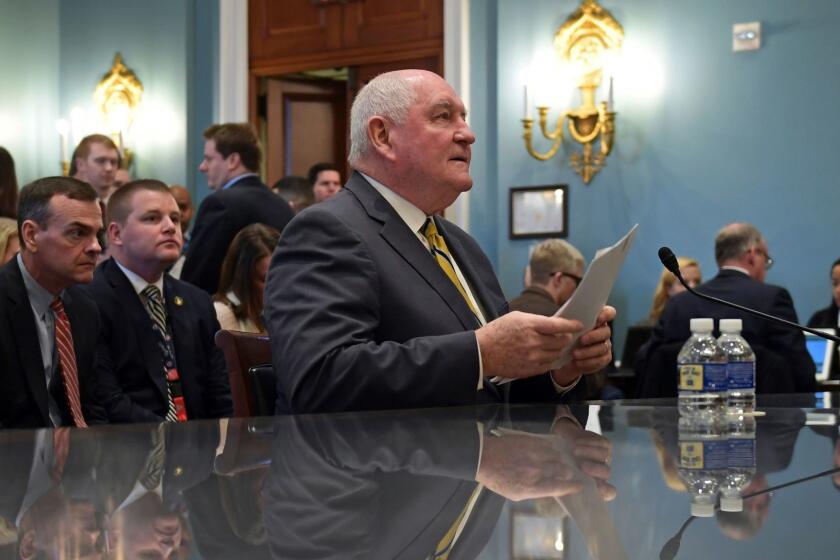Trump acts to take food stamps away from 700,000 recipients

- Share via
The time has come to put the question bluntly: What does President Trump have against food stamp recipients?
The issue arises from the administration’s newest initiative to throw people off the food stamp rolls, made final on Wednesday. It’s a rule aimed at tightening the work requirements for adult food stamp applicants without children; the administration estimates that it will pare the number of recipients by almost 700,000.
Under current rules, childless adults are limited to three months of benefits within any 36-month period unless they work at least 20 hours a week. The government has allowed states to waive the work requirement in any area with an unemployment rate of 2.5% or higher. The new rule, which will go into effect in April, raises the unemployment threshold to 6%.
Limiting access to ... food assistance does not support underemployed and unemployed people in finding work. Rather, hunger is a barrier to employment.
— California Health and Human Services Agency Secretary Mark Ghaly
As is often the case, administration officials portrayed the cutback as being undertaken out of concern for the recipients’ moral character. Agriculture Secretary Sonny Perdue told reporters in a conference call that the goal was “to restore the dignity of work to a sizable segment of our population.”
He added that the rule change was designed to show solicitude for the taxpayers who foot the bill. But changes such as these tend to increase administrative costs for the states that manage the programs. To the extent the rule increases food insecurity in the target population or contributes to malnutrition, those conditions impose social costs, too.
As for the budgetary savings, USDA places them at about $1.1 billion a year. That’s about two-hundredths of a percent of the federal budget.
To save thousandths of a percent of the federal budget, Trump wants to throw half a million children off the school lunch program.
Moreover, the rationale for the tightening is upside down. Food stamps don’t foster joblessness — they’re an antidote.
As California Health and Human Services Agency Secretary Mark Ghaly observed Wednesday: “Limiting access to CalFresh food assistance does not support underemployed and unemployed people in finding work. Rather, hunger is a barrier to employment. Further, limiting access to food makes a family’s entire financial situation more precarious and increases the chances of falling into homelessness.” CalFresh is the state’s federally funded food stamp program.
Wednesday’s rule change is the first of three that the Trump administration has in the works for the food stamp program, which is formally known as the Supplemental Nutrition Assistance Program, or SNAP.
Another would limit states’ ability to deem families eligible for food stamps based on their enrollment in other government assistance programs, an arrangement through which income eligibility limits also can be raised.
For some reason, conservatives have always harbored a special hostility for the food stamp program.
As we reported earlier, that change would strip food stamps from about 1 million households with children and render about a half-million children no longer eligible for free school meals.
The third rule would alter the calculations that go into determining income eligibility for food stamps.
Taken together, the three changes would reduce SNAP rolls by at least 15% in 13 states, according to an estimate by the Urban Institute, which said that the largest reductions would hit the District of Columbia (24%) and Nevada (22%). Total benefits would fall by at least 15% in nine states.
The campaign to cut SNAP benefits has a long, discreditable history. In 2018, the then-GOP-controlled House tried to cut the SNAP budget by $17 billion over 10 years in part by tightening work rules (the program costs about $70 billion a year). Although Democrats were unanimously opposed, bizarrely the bill was killed by the House’s extreme right-wing caucus, which held it hostage to an immigration measure it favored.
Back in 2013, there was another attempt at cutting food stamps. That effort to cut SNAP by $20 billion over 10 years deserves a place in the Capitol Hill Hall of Shame because it was heavily supported by numerous members of Congress who had slurped deeply from government crop supports and subsidies as farm owners.
Rep. LaMalfa pockets his farm subsidies, votes to cut food stamps
Among them was Rep. Doug LaMalfa (R-Richvale), who carried on about the need to “retract just a little bit of the spending [on food stamps] ... to try to get this reform in place.” He called the $20-billion cut a “modest” change.
As it happens, LaMalfa’s family farm had collected $5.1 million in government crop subsidies from 1995 through that year, according to the Environmental Working Group. At the time, 11% of the residents of Butte County, LaMalfa’s home county, were receiving SNAP benefits.
Efforts to cut back on food stamps merely underscore the vulnerability of programs that serve a narrow population, especially needy households with scarcely any political weight or voice. These programs are easily slashed by government officials and lawmakers who want to look like budget warriors.
We reported in October, when the administration first proposed the rule changes, that government officials and lawmakers who take a casual approach to the nutritional health of the American public are mortgaging the country’s future. As Hilary Hoynes of UC Berkeley has observed, “the benefits of nutrition support can persist well into adulthood for those who have access to the program before birth and during early childhood.” The benefits include improved achievement in school and lower rates of obesity, hypertension and heart disease in adulthood.
Perdue’s hand-wringing about the need to put able-bodied SNAP enrollees to work is just cynical. According to government statistics, in fiscal 2017, the most recent year available, about 7.8% of all SNAP recipients were nondisabled childless adults, the target population of the latest rule; their average income was about 33% of the federal poverty level, or $375 per month.
Contrary to conservatives’ standard image of a vast population living the high life on food stamps for their entire lives, most were on SNAP only for short periods — only 2% of those on SNAP for eight years or more are nondisabled childless adults. Their average monthly food stamp benefit came to $157 per person, or about $5.20 per day.
In other words, the food stamp policy is cruel, unnecessary, and penny-wise and just plain foolish.
More to Read
Inside the business of entertainment
The Wide Shot brings you news, analysis and insights on everything from streaming wars to production — and what it all means for the future.
You may occasionally receive promotional content from the Los Angeles Times.














